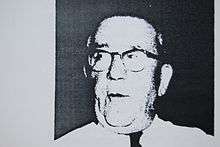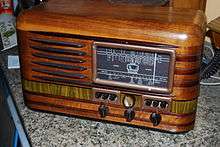Packard Bell
|
| |
| Subsidiary of Acer | |
| Industry | Computer hardware |
| Fate | acquired by Acer Inc. in 2008 |
| Founded | 1986 |
| Founder | Beny Alagem |
| Headquarters | Nijmegen, Netherlands |
Area served | Europe, Africa |
| Products |
Desktops Laptops Netbooks Monitors Tablets |
| Parent | Acer Inc. (Since 2008) |
| Website | packardbell.com |
Packard Bell is a Dutch-based computer manufacturing subsidiary of Acer. The brand name originally belonged to an American radio manufacturer Packard Bell founded by Herbert "Herb" A. Bell and Leon S. Packard in 1933. Some websites use 1926 as the founding date when Herbert Bell was an executive with Jackson Bell Company, Los Angeles, California.[1][2] In 1986, Israeli investors bought the name for a newly formed personal computer manufacturing company producing discount computers in the United States and Canada. In 2000, Packard Bell, then a subsidiary of NEC, stopped its North American operations while remaining a leading brand in the European markets. In 2008 it was acquired by the Taiwanese consumer electronic firm Acer in the aftermath of its takeover of Gateway computers. Gateway products are now sold in the Americas and Asia, while Packard Bell products are sold in Africa, Europe and the Middle East.
History

Founding: Packard Bell Company
The original Packard Bell name began in September 1933. Herbert Bell (birth name Herbert Anthony Zwiebel), former business partner of Jackson Bell Radio Company in Los Angeles, formed Packard Bell. Jackson Bell went into receivership that year due to financial problems. Jackson Bell was one of the few RCA licensed radio manufacturers on the west coast of the United States. Bell partnered with Leon S. Packard. In 1934, they marketed their first radio, the Model 35A (carryover from Jackson Bell). In 1935, Leon Packard sold his partnership to Herb Bell, being skeptical of its future. Herb Bell managed to obtain the RCA license for manufacturing superheterodyne radios. Based in Los Angeles, Packard Bell along with Hoffman Radio became well known regional makers of consumer electronics. Packard Bell ventured into television quickly due to the RCA royalty-free patents.[3]

Packard Bell radios had a distinguishable styling: The tuning dial showed the call signs of American and Canadian radio stations west of the Rocky Mountains. The idea came from Bell's mother, who had trouble reading the tuning dial. Packard Bell was a family business: Herbert Bell's brothers Arthur, Albert, Elmer and Willard participated in major departments from design, manufacturing and marketing.
Packard Bell did quite well and, like Hoffman Electronics, became a recognized name in regional consumer electronics . After World War II and through the 1960s, Packard Bell was a very profitable company. Packard Bell went public in 1955. The firm expanded into defense electronics during World War II and continued into the 1970s. Herb Bell died in the early 1970s .
Teledyne Packard Bell years
In 1968, Packard Bell was sold to Teledyne. Teledyne was interested in reaching further into the consumer electronics business. The sales was converted into stock at an exchange of 1 share of Teledyne Common Stock equals Seven and one-half shares of Packard Bell Common Stock. The Packard Bell name remained, but with Teledyne ahead of it, hence Teledyne Packard Bell.[4]
Computers: the new Packard Bell
In 1986, Beny Alagem and a group of Israeli investors bought the Packard Bell name from Teledyne[5] and resurrected it as a manufacturer of low-cost personal computers. Their computers were among the first IBM PC compatibles sold in retail chains such as Sears.[6]
According to Fortune Magazine, Packard Bell sometimes benefited from misplaced name recognition, with consumers (especially first-time computer buyers) and even some salespeople erroneously associating the company with others of similar name, such as Hewlett-Packard, Pacific Bell, and Bell Laboratories. Packard Bell's old slogan, "America grew up listening to us. It still does", may have facilitated the confusion.[7] The company also sold nearly identical systems under different names, making comparison difficult.

Aside from price and brand misnomers, Packard Bell's success in number of units sold may have come from two areas of innovation: 1) branding and industrial design, provided by the San Francisco offices of frog design; and 2) its boot-up shell Packard Bell Navigator, created by The Pixel Company in Seattle. They targeted a huge section of consumers who were inexperienced using computers. Frog design gave the look of quality and utilized innovations such as color-coding cable connectors (first seen on the IBM PS/2), while Navigator provided the ability for users to launch installed programs by clicking on-screen buttons, and then later a house metaphor.[8] During this phase, returns dropped from 19% to 10%, and sales grew exponentially. In late 1995 to early 1996 Microsoft forced boot-up shells off OEM computers by updating its Microsoft Windows distribution agreement (OPK 2) and Packard Bell, without a clear on-shelf differentiator, saw sales begin to tumble.
In 1995, Compaq sued Packard Bell for not disclosing that Packard Bell computers incorporated used parts. This practice was, in fact, widespread in the computer industry including Compaq itself. However, unlike its rival companies, Packard Bell was judged not to have advertised the practice sufficiently in its warranties (Compaq, for instance, disclosed it in the warranty statement).[9] The company was the subject of several lawsuits, and paid millions of dollars in settlements. In 2005, PC World Magazine ranked the Packard Bell computers of 1986–1996 as the worst PCs manufactured of all time.[10][11] In addition, one out of six Packard Bell PCs sold at retail was returned, a rate double the industry average.[10]
In 1995, Packard Bell acquired Zenith Data Systems from Groupe Bull in a deal which saw Groupe Bull and NEC taking a larger stake in Packard Bell[12] to create a $4.5 billion company. The company then became integrated with NEC Computers. Its 15% market share made it the largest PC manufacturer, in terms of units shipped, in the United States. However, Compaq overtook it in retail sales in mid-1996, and cemented its lead the next year with the release of a $999 PC in March 1997.
Packard Bell posted losses totaling more than $1 billion in 1997 and 1998. In the U.S., price pressure from Compaq and, later, eMachines, along with continued poor showings in consumer satisfaction surveys made it difficult for the company to remain profitable and led to Alagem's departure in 1998. In 1999, NEC began withdrawing the Packard Bell name from the U.S. market, while keeping it in Europe, where the brand was untainted by allegations of sub-standard quality.[13]
Packard Bell Europe
In 2000, NEC withdrew Packard Bell from the U.S. market, selling their Utah-based call centers, all its US inventory and all US product liability to Alorica Inc, who was responsible for providing support to all remaining US customers. Packard Bell also entered other businesses such as MP3 players. In 2004, the company changed its logo and began manufacturing media products for television and wireless networking.
Packard Bell also sells accessories and has started operating in other continents. In September 2006, Packard Bell was bought by John Hui (the former owner of eMachines). Now known as Packard Bell Europe B.V., the company relocated to Nijmegen in the Netherlands.
In August 2007, the Chinese PC manufacturer Lenovo confirmed its interest in acquiring Packard Bell in a move to expand its products into Europe by placing an offer for Packard Bell.[14] In January 2008, Acer announced that it had acquired a 75% controlling share in the parent company of Packard Bell due to ownership rights that it had acquired when it purchased Gateway the year before, enabling Acer to counter-offer any third-party bid on Packard Bell, leading to a takeover.[15] Packard Bell is now under the same corporate division of and shares products with Acer's subsidiary Gateway, Inc., a notable former competitor.
Sponsorship
From 1996 until 2000, when Strongbow took over the contract, Packard Bell sponsored English football club Leeds United.
From 2009 to 2010, the name Packard Bell has been seen on the FIAT Yamaha MotoGP racebike of World Champion Valentino Rossi of Italy.[16] Packard Bell also dropped their sponsorship from the Professional Electronic Sports Team, 4Kings.
Possible return to the United States
A press release distributed by PRWeb on August 2nd, 2015[17] stated that the Packard Bell name had been purchased by JMM Lee Properties for use in the United States, and that products would go on sale that month. According to numerous trademark websites, Packard Bell is a registered trademark for use in the United States only by JMM Lee Properties. According to the press release on PRWeb, the new Packard Bell brand in the United States was to be unaffiliated with the brand run by Acer in Europe. The trademark was officially registered on September 8th, 2015. A year later, the brand still has no North American web presence, and no Packard Bell-branded products are sold in the US market.
References
- ↑ Source: Computerhope
- ↑ Source: Computer History Museum, in Los Angeles
- ↑ Paul, Floyd A. (1994). Los Angeles Radio Manufacturing: The First Twenty Years (1922–1942). Glendale, CA: Floyd A. Paul. pp. 41–46.
- ↑ Magazine, Billboard. "Teledyne Buys Packard Bell". January 20, 1968. Billboard. Retrieved 2013-03-04.
- ↑ BetaNews | NEC Sells Packard Bell to Calif. Investor
- ↑ Packard Bell sells more PC's in the U.S. than anyone, so just who are these guys?, Fortune, June 12, 1995
- ↑ Sprout, Alison L. with Coxeter, Ruth M., Packard Bell sells more PCs in the U.S. than anyone. So just who are these guys?, Fortune Magazine, June 12, 1995, http://money.cnn.com/magazines/fortune/fortune_archive/1995/06/12/203837/index.htm
- ↑ Linebach, Nath
- ↑ "Packard Bell Suing Compaq". Chicago Tribune. 11 October 1995. Retrieved 23 December 2015.
- 1 2 Tynan, Dan. 10 Worst PCs of All Time, PC World, March 19, 2007
- ↑
- ↑ Berley, Max (8 February 1996). "Groupe Bull Quits PCs in 3-Way Deal". International Herald Tribune. Archived from the original on 25 October 2005. Retrieved 10 March 2014.
- ↑ NEC disables Packard Bell NEC, ZDNet, November 3, 1999
- ↑ Lenovo close to acquiring Packard Bell
- ↑ Acer Buys 75 Percent of Packard Bell – Washington Post
- ↑ "Packard Bell sponsor of Yamaha Factory Racing Team Changeover of sponsorship from Acer". Acer Group. 2 February 2009. Retrieved 23 December 2015.
- ↑ http://www.prweb.com/releases/2015/08/prweb12881950.htm
